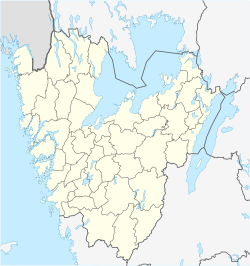Lidköping
| Lidköping | |
|---|---|

|
|
| Coordinates: 58°30′N 13°11′E / 58.500°N 13.183°ECoordinates: 58°30′N 13°11′E / 58.500°N 13.183°E | |
| Country | Sweden |
| Province | Västergötland |
| County | Västra Götaland County |
| Municipality | Lidköping Municipality |
| Area[1] | |
| • Total | 15.52 km2 (5.99 sq mi) |
| Population (31 December 2010)[1] | |
| • Total | 25,644 |
| • Density | 1,652/km2 (4,280/sq mi) |
| Time zone | CET (UTC+1) |
| • Summer (DST) | CEST (UTC+2) |
| Climate | Cfb |
Lidköping is a locality and the seat of Lidköping Municipality in Västra Götaland County, Sweden. It had 25,644 inhabitants in 2010.[1]
It is neatly situated on the southern shore of Lake Vänern and sometimes refers to itself as "Lidköping by Vänern", to distinguish itself from Linköping near Sweden's east coast. Attempts have been made to change the official name to "Lidköping vid Vänern" but these attempts have not been successful.[2]
Contents
Geography[edit]
The town of Lidköping is divided by the stream Lidan, flowing through the central city. The eastern side of it is called the old town, and the western side is known as the new town.
The municipality of Lidköping is together with its eastern neighbor Götene located on the Läckö-Kinnekulle peninsula. In association with several large local companies, they have a colloquial tourism company known as "Götene-Lidköping Vänern Turist AB".
History[edit]
Lidköping got its charter on July 21, 1446, and thus qualifies as one of the now defunct Cities of Sweden. The city arms are almost as old. The design has varied throughout the centuries, but has always depicted a seated bishop. It is disputed if it depicts an actual bishop, but was in the 20th century decided to be a depiction of the bishop Saint Nicholas.
Around 1650, the city was decided to be incorporated into the countship of Jakob De la Gardie. However, in 1655 the crown decided to regain administration of the city. To make up the loss, De la Gardie was then given the right to found a new city on the western side of the river, starting 1670. In 1672 the foundations were laid, and the new city grew rather quickly. In 1683, both sides of the city Lidköping were declared unified by the Crown, who also reclaimed possession of them both.
-
Lidköping circa 1700, from Suecia Antiqua et Hodierna
The old town burned down in 1849, and large part of the new town were also damaged. Following the fire, both towns were rebuilt according to a check pattern.
Symbol[edit]
Lidköping is working hard to market itself as "Lidköping by Vänern". In line with this quest, they are developing a profile plan, wherein they have established the use of a symbol depicting its location by Vänern. The symbol is used in all official context, and also on the road sign when entering Lidköping.
Sport[edit]
Villa Lidköping BK has one of the best bandy teams in Sweden. In 2016 they reached the final of Elitserien. Sparbanken Lidköping Arena is the home venue.
Famous people from Lidköping[edit]
- Linda Sundblad
- Carl Dalemo of the band Razorlight
- Gunnar Wennerberg
- Anders Järryd
- Reorus Torkillus
- Mary Anderson
- Evy Palm
- Rasmus Dahlin
- Jas The Cat
- Timmie Johansson
See also[edit]
- Municipalities of Sweden
- Köping (concept)
References[edit]
- article Lidköping from Nordisk Familjebok (vol. 16, 1912) (in Swedish)
- ^ a b c "Tätorternas landareal, folkmängd och invånare per km2 2005 och 2010" (in Swedish). Statistics Sweden. 14 December 2011. Archived from the original on 10 January 2012. Retrieved 10 January 2012.
- ^ http://www.aftonbladet.se/nyheter/article14605768.ab
External links[edit]
| Wikimedia Commons has media related to Lidköping. |
- Official website
- Läckö Kinnekulle - The "Götene-Lidköping Vänern" tourism company






